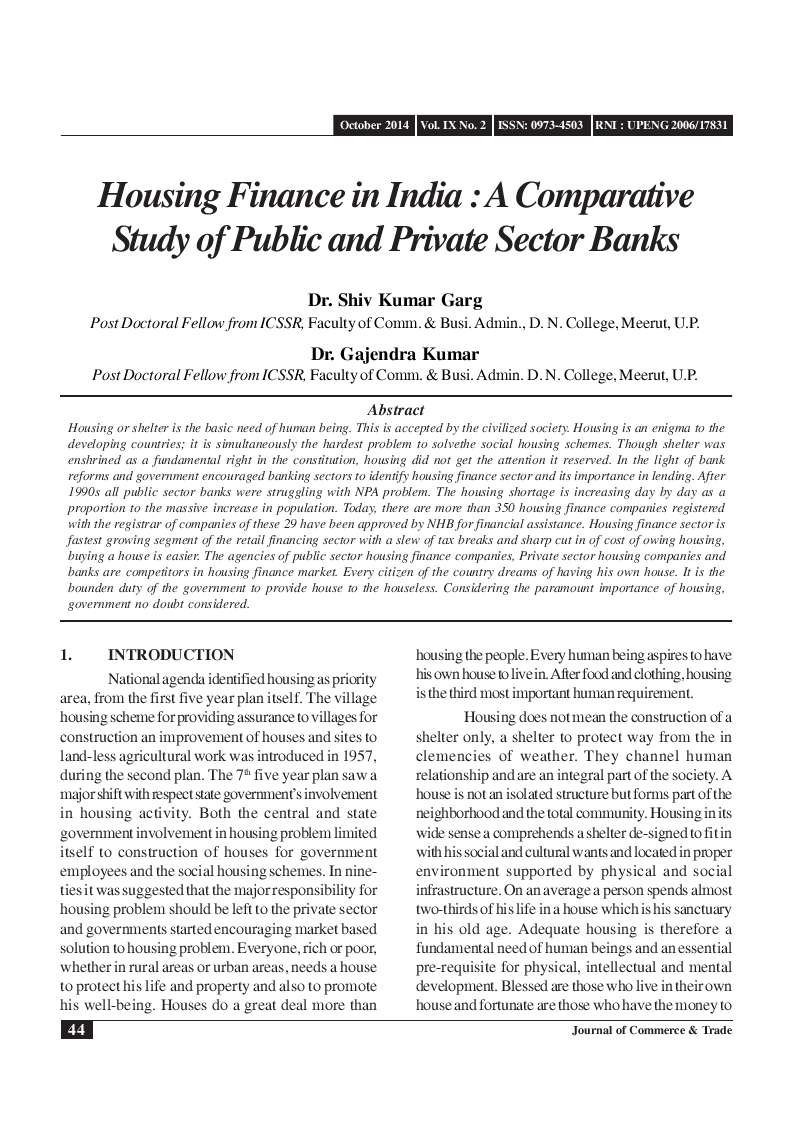Housing Finance in India : A Comparative Study of Public and Private Sector Banks
DOI:
https://doi.org/10.26703/jct.v9i2.258Keywords:
Housing Finance, India, Public Sector Banks, Private Sector BanksAbstract
Housing or shelter is the basic need of human being. This is accepted by the civilized society. Housing is an enigma to the developing countries; it is simultaneously the hardest problem to solvethe social housing schemes. Though shelter was enshrined as a fundamental right in the constitution, housing did not get the attention it reserved. In the light of bank reforms and government encouraged banking sectors to identify housing finance sector and its importance in lending. After 1990s all public sector banks were struggling with NPA problem. The housing shortage is increasing day by day as a proportion to the massive increase in population. Today, there are more than 350 housing finance companies registered with the registrar of companies of these 29 have been approved by NHB for financial assistance. Housing finance sector is fastest growing segment of the retail financing sector with a slew of tax breaks and sharp cut in of cost of owing housing, buying a house is easier. The agencies of public sector housing finance companies, Private sector housing companies and banks are competitors in housing finance market. Every citizen of the country dreams of having his own house. It is the bounden duty of the government to provide house to the houseless. Considering the paramount importance of housing, government no doubt considered.
Downloads
Metrics
References
AshlynAiko Nelson. (2010). Bailing Out Underwater Mortgages. SPEA Insights School of Public and Environmental Affairs (SPEA).
Bank, N. H. (2012). Report on Trends and Progress of Housing in India . New Delhi: National Housing bank.
Ch. HariGovindaRao, D. N. (2012). An Assessment of the Indian Housing Finance System: Crucial Perspective. IOSR Journal of Business and Management, 5(5), 11-24.
Dr. P.S. Ravindra, D. P. (2013). Operational and Financial Performance Evaluation of Housing Finance Companies in India (A Case Study of LIC Housing Finance Limited and HDFC). International Journal of Management and Social Sciences Research, 2(7),
Kundu, A. (2012). Report of The Technical Group On Urban Housing Shortage (TG-12) (2012-17). New Delhi: Ministry of Housing and Urban Poverty Alleviation National Buildings Organisation.
NHB. (2005). Report On Trend & Progress Of Housing In India 2005. New Delhi: National housing Bank.
NHB. (2009). Report on Trends and Progress of Housing in India . New Delhi: National Housing Bank.
S.Rajalakshmi, C. A. (2013). A Study On Housing Loan Borrowers Of Public And Private Sector Banks In Thoothukudi Area. Researchjournali’s Journal of Commerce, 1-27.
Singh, J. T. (2012). Regulatory Framework of Housing Finance Companies in India. VSRD International Journal of Business & Management Research, 2(9), 488-495.
Thiwari, P. (n.d.). Developments in Housing Finance in India . Housing fianceinternational , 37-46.
(2012). Twelfth Five Year Plan (2012–2017) Faster, More Inclusive and Sustainable Growth. New Delhi: SAGE Publications India PvtLtd .
Basic Statistical Returns of Scheduled Commercial Banks in India, RBI (Various Issues)
Websites
www.rbi.org.in
www.sbi.co.in
www.obcindia.co.in
www.syndicatebank.in
www.nhb.org.in
www.hudco.org

Additional Files
Published
How to Cite
Issue
Section
License
Copyright (c) 2014 Journal of Commerce and Trade

This work is licensed under a Creative Commons Attribution 4.0 International License.







